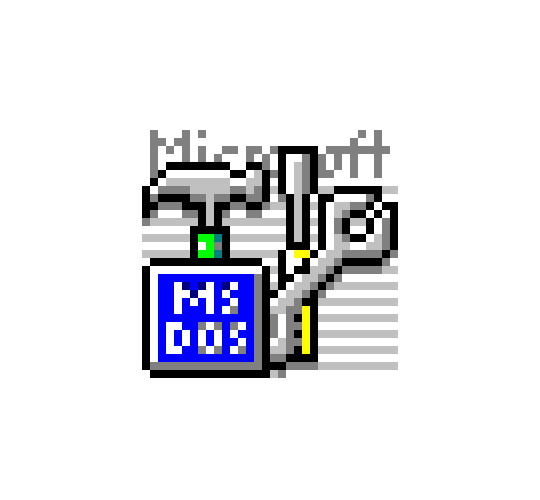#QBasic
Explore tagged Tumblr posts
Text
Get started with QBasic ...

Contents At A Glance
Introduction to QBasic
Using The QBasic Environment
Working With Data
Operators And String Variables
Advanced Input And Output
Making Decisions With Data
Controlling Program Flow
Data Structures
Buit-In Functions
Programming Subroutines
Disk Files
Sound And Graphics
Debugging Your Programs

Post #344: Greg Perry & Steven Potts, Crash Course in QBasic, The Fastest Way To Move To QBasic, Second Edition, QUE Corporation, Indianapolis, USA, 1994.
#programming#retro programming#vintage programming#basic#basic programming#education#qbasic#quickbasic#qbasic programming#microsoft#que corporation#i love qbasic#i love quickbasic#dos programming
18 notes
·
View notes
Text
Bufcolor – this is a new word
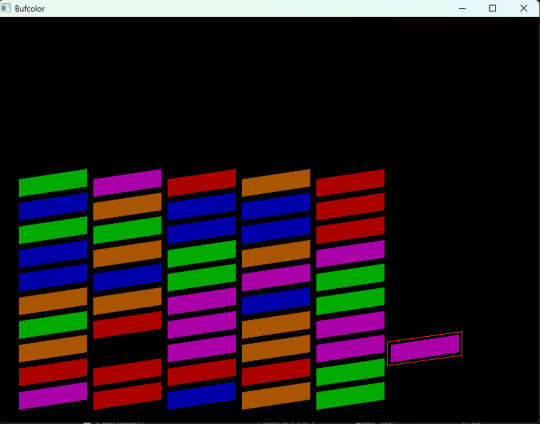
Game about different colors. You need to collect/build columns with colors. Fill every column with its own color. Control with keyboard. Arrows and space. And, also, there is a buffer. It is additional little column, where you put a little cube, that you do not need now. Buffer contains only one little cube. It is need for exchange.
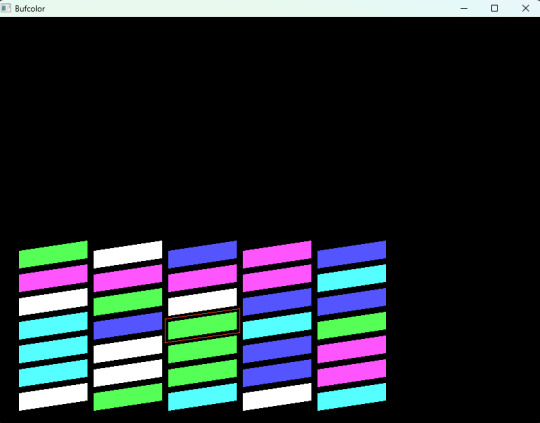
For a long time, I wanted to make lots of small games with Basic. And, this time, I achieve this point. It is, exactly this kind small game. About different colors. Little cubes. There are several columns. For example, 3 or 5.
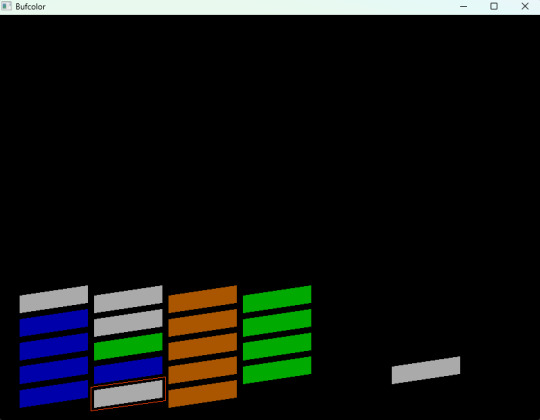
And, also, there is little column number 6 – this is buffer. Withing this you put little cube for exchange. In buffer it can be only one little cube. And you need to set all the colors in columns, except buffer with same colors. First little column with green, second with red. This is about you. You select colors. But only one idea – each column need to be with its own color. With the result. In this case you complete the level.
youtube
This kind of entertainment can be with Ms Dos, Nes, MSX, other 8 bit computers in 80s. It is funny thing, entertainment for engineer at the evening. To collect columns.
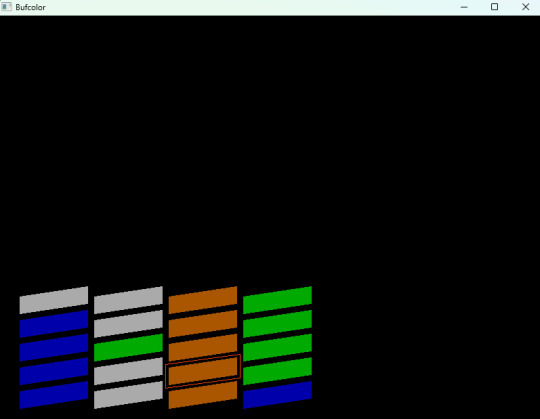
There are several color palette. And two types of visual view. First – it is simple columns. Something like to down view. Everything is straight. Second - it is isometrical. Something like pseudo 3d. With some angle. So this way it is more beautiful. But a little less with understanding. Amount of columns is different from 3 to 5.
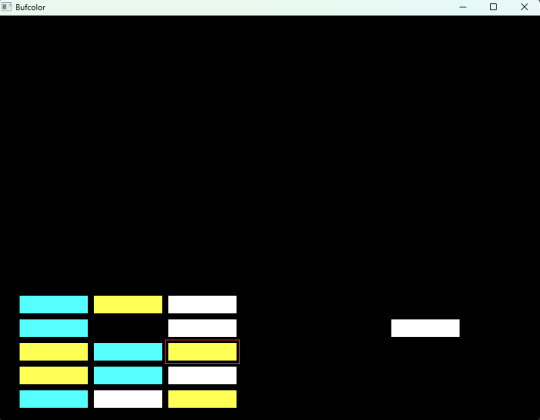
I had for a long time lots of ideas. I think they are for Basic. Ideas for simple games. And so this is a moment of realization – it is here. With using of Basic. This is one more small game.
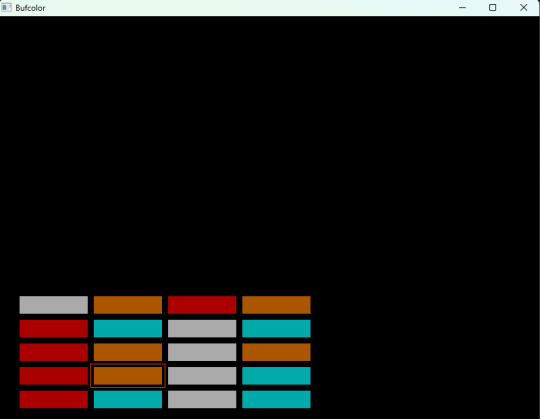
Title is consist with two words. But it is as a one word. New word. Bufcolor. This is after word buffer. And color. This is all the idea. You collect columns with colors. And you need one more little column as buffer for exchange. And here it is to appear a new word – bufcolor.
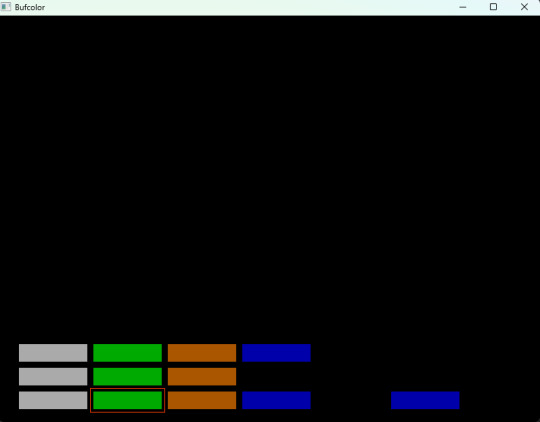
So, how it is cool to know how to programming with Basic. With suing this language you can do realization of lots your ideas. For example, computer games. Spirit of 80s. 8 bit computers. This is just amazing. Once again, little plus goes to side of the Basic. And dialects of Basic. Such as Free Basic. This time for this thing. And amazing code editor – Gvim.
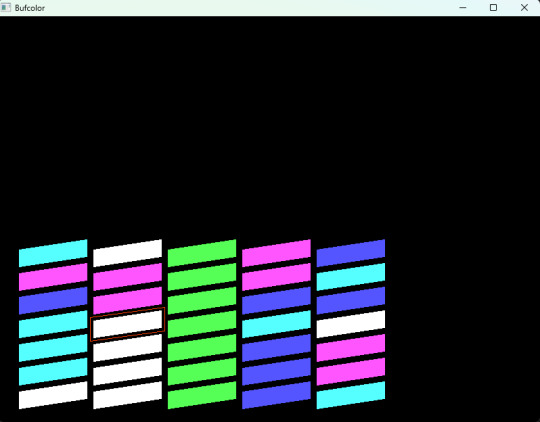
Little columns and colors. And, also, a buffer for 1 little cube. To replace little cubes, when all of them are full in columns. With most beginning, they are filled with chaos order and random order. And you need to sort them. And to have a situation – that every column is with its own one color. You need this buffer. It is very valuable term. Without it - it will be impossible. And buffer -it is so minimal length little column with 1 little cube. You can put in buffer only one little cube. But this is enough. To start to make exchanges between little columns.
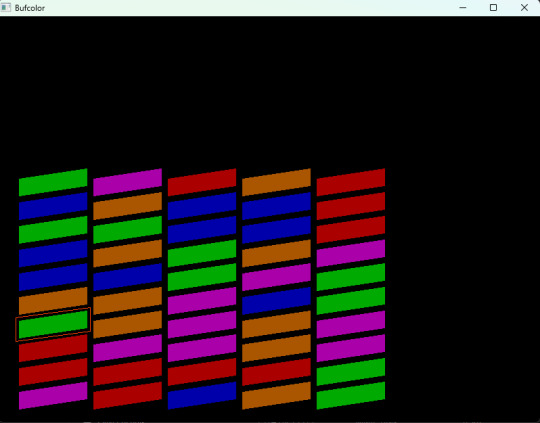
Select little cube. Put in a buffer. Later, select little cube from columns and put it to the empty place. Later, take from buffer little cube, which is already there and put it at the empty place in columns. For example, this way.

Control is simple. With arrows from the keyboard. And space to select a column. Or cancel your selection. Select you made and next do move. This is a fantasy, dream about little columns and different colors. There are max columns with 5. And number six for buffer, always 6 -it is buffer. So, palette is with 5 colors. But colors for little cubes are random way to go. So, every time you launch -you see different color picture. Firs little cube was green.it is now red during next start. And alter blue. So, neat again – some else color.
And yes - have your excellent Basic day!

Basic Pascal version 1.18 "Duckling" – most newest version. In this version there are 4 new games! Puddles at Countryside, Duckling Pseudo 3D, Road to Countryside, Duckling Goes 2D. And even more retro games! It is a pack of retro games with modern versions of Basic and Pascal.
It is now in development new version Basic Pascal pack games. This game will be included in a new version.
Basic Pascal: http://www.dimalink.tv-games.ru/games/basicpascal/index_eng.html Website: http://www.dimalink.tv-games.ru/home_eng.html Itchio: https://dimalink.itch.io/basic-pascal
#retro game#retro programming#qbasic#free basic#arcade#logic#puzzle#8 bit#ms dos#msx#simple game#colors#columns#row#lines#exchange colors#replace colors#buffer with color#1980s#8 bit computers#build collumn#collect colors#sort#devlog#gamedev#Youtube
8 notes
·
View notes
Text
So, I'm looking for what I believe to be a piece of completely lost media - the Killer Kombat Pong series of QBASIC games that were distributed via the AOL games board sometime between 90 and 98. I've found similar games in the genre (Pong Worz, Pong Kombat 1+2), but not the KKP series. This is a shame, because KKP was the most polished and playable of the games - the first was very rudimentary with only a multiplayer mode and three characters, but the second and third games added full arcade modes (with character endings!) and a full roster.
If anyone knows of any mass archives of AOL-distributed BASIC games, please let me know.
@foone - I think you're my best hope for this.
8 notes
·
View notes
Video
youtube
MixMystery - Cooey's Call: Piano Edition - Victory
#youtube#video game music#video-games#qbasic#piano#piano music#visualization#vizzy#indie music#indie#indie rpg
2 notes
·
View notes
Text
I miss extended ASCII from dos 6.2. I want my lines, and chr 219.
2 notes
·
View notes
Text
IFComp 2023: Jim McBrayne's Have Orb, Will Travel
This is a review of a game entered into IFComp 2023, the twenty-ninth annual interactive fiction competition. This year, there are 74 games in the Comp, all free to play. There’s some good stuff in there this year! Anyone is welcome to play and vote on the entries during the Comp period, and you need vote on only five games by the middle of November for your votes to count toward the games’ overall scores!
As is my wont when writing IFComp reviews, I shamelessly steal Jacqueline Ashwell’s rubric for scoring, because, well, it’s thoughtful and fair.
This review, like all of my reviews, is potentially spoilery. You may want to avoid reading it until after you’ve played the game. That’s up to you.
So this is a very, very old-school parser game, written by Jim McBrayne, who's been writing parser games in various BASIC dialects for forty years or so now. That's a long time, and a lot of dedication to a single language! Have Orb, Will Travel is written in a modern, compilable BASIC, QBASIC64, a descendant of the QBASIC that used to come pre-installed with Windows. Playing this really took me back to my roots, playing puzzle-oriented parser IF on what was, in comparison to modern equipment, amazingly underpowered hardware. (Coincidentally, I wrote a bit last week about my early experiences playing parser-based interactive fiction.) It's a largeish game, with fifty-some rooms that I'd visited by the time I reached the end, and a number of puzzles standing between the player and the end of the game.
Seeing a bit of parser IF that fit right in with the better homebrew of the 80s was quite an experience; but it also really made me cognizant of how much the genre as a whole has gained since, say, 1982 or so. Have Orb feels in many ways like it resolutely refuses to learn from what interactive fiction has learned and how it has evolved since then: there are no NPCs to interact with, no puzzles that are not fundamentally about object manipulation. Puzzles involve a lot of guesswork and just exhaustively trying every verb on every object.
The descriptions of objects are more than a little laconic:
X UNDERGROWTH It restricts travel in several directions. X FERN They're of a type you've never before seen. X SHELF On the shelf you see a small book. X ROCK FACE It's pretty small as rock faces go. X CIRCLE It's embossed into the stone.
The location descriptions do a little bit better at being evocative, but really, the overall feeling is one of checking off the boxes of writing necessary room and object descriptions in order to fill the map with puzzles.
Similarly, interacting with the game's objects is often a struggle in ways that I wish had remained in the 1980s:
X BOOK The cover of the book shows… SPELL AND ASSISTS OPEN BOOK You open the book. READ BOOK Page 1 Where the choices are nine You shorten the time By considering prime G Page 1 Where the choices are nine You shorten the time By considering prime G Page 1 Where the choices are nine You shorten the time By considering prime TURN PAGE You turn to the next page. READ BOOK Page 2 - + + + - - - - - - + + + - - - - - - + - - - - + + + - - + + + - - - + + - - - - - G Page 2 - + + + - - - - - - + + + - - - - - - + - - - - + + + - - + + + - - - + + - - - - - PRESS RELEASE I have no knowledge of this "RELEASE" of which you speak. TURN PAGE You turn to the next page. READ IT [The page] Page 3 Limbok Spell ------------ The Limbok Spell is cast by invoking the words 'LIMBOK [object]'. It only affects items which can be carried, and causes them to levitate for just a brief moment or two. G [The page] Page 3 Limbok Spell ------------ The Limbok Spell is cast by invoking the words 'LIMBOK [object]'. It only affects items which can be carried, and causes them to levitate for just a brief moment or two.
This need to manually open and close the book and manually turn the pages is extremely awkward; contrast how easy it is to get Ebeneezabeth to read the entirety of the journal that occurs in Ryan Veeder's The Little Match Girl 4 in this year's Comp. There are many other things about the parser that feel awkward in 2023: the inability to simple TAKE an object which is contained by another object (there are many places where you cannot simply, for instance, GET SPHERE, but it is instead necessary to GET SPHERE FROM DRAWER); the lack of synonyms for things, especially things with long names; the way that parsing error messages are sometimes misleading or inscrutable.
The puzzles themselves often seem random and unmotivated: manipulating an object affects something in the distance, but it's often difficult to determine what is affected, requiring substantial exploration after changing something. Solutions to puzzles are often clued in ways that have no narrative explanation: why are the necessary numerical settings for a device written down and left lying on a scrap of paper? Why is there a book containing exactly three magic spells (only two of which are directly needed to solve the game) and hints required to solve two puzzles? Why is the book simply left out, easily available to the adventurer early in the game? Why is another puzzle dependent on another scrap of paper rather than being put into the puzzle-and-spell book? Backstory could be provided, but is not; and it is no longer the case that the primitive hardware of our day regrettably prevents us from including enough text to explain the backstory. Similarly, if the solution to a puzzle midway through the game involves producing the first three prime numbers, why is there a hint at that written down at all, since it seems that anyone who designed a mechanical device to check for those three numbers would be able to remember the pattern instead of needing to write it in a book?
All in all, there are too many unanswered questions for it to be a satisfying story: why is this orb necessary to the safety of the country, and how did it come to be where it is? If the council hiring you hid items where you would need them, how did they know that you would need them, and where, and why didn't they simply retrieve the orb themselves if they had all of this information? Who are the people moving the chest around? Why is there a TARDIS in an underground cave? Why is there a set of three crystalline objects in the shapes of elementary Pythagorean solids? Why does retrieving the orb end the game, instead of (as the title suggests) begin the traveling?
The answers to many of these questions, I think, is simply that they are the result of constraints imposed by the QBASIC design system; but that's hardly a satisfactory explanation from the player's point of view: the player didn't choose the design system. There are additional awkwardnesses associated with the design system: save files can only be created in the game's own main directory, and names must be exactly 20 characters long, consisting only of letters and numbers; being unable to change the aspect ratio of the display to something other than the aspect ratio of my laptop monitor makes it hard to draw a map in a separate window; fully justified text looks rather awful when the justification method involves adding not pixels but whole spaces to whitespace characters.
And—this is a quibble, but was an annoyance while playing through certain parts of the game—having a constant background noise of birds chirping is pleasant but seems an inappropriate atmospheric sound to play during the parts of the game set underground, in caves, when I would expect that birdsong would be inaudible. Another rather quibbly complaint: the geography stretches the bounds of credibility in some ways. How big is this "cottage" that the player enters at the very beginning of the game and to which he keeps returning? Believing that it has a second story and a basement is one thing; but surely it stretches the bounds of credibility to see all of those secret rooms. Similarly, many branches in the mazes wind up being one-way passages that return to the cottage in ways that are not only annoying (lots of backtracking to get back to the junction where the wrong decision was taken), but also seem difficult to reconcile with the physical geography of the game (how on earth can that sequence of moves put me back there?).
There are places where the game is satisfying, but all in all, it doesn't make me eager to return to 1983-era parser IF.
My rating: 4/10.
(I also drew a map of the game's geography as I played.)
(This review is based on the revised version of the game released on 25 October 2023.)
#interactive fiction#parser IF#IFComp#IFComp 2023#2023#Jim McBrayne#Have Orb Will Travel#design systems#programming#QBASIC#QBASIC64#puzzles#classic parser IF
1 note
·
View note
Text
149 Days of Coding
My Actual coding booth 😃 1. Introduction: Embracing a New Beginning at Day 149 Of course I know it too late to start the blog from day 149, but I was very busy with my old job, now I’ve been released a week ago, and I’m free to do what I want now. 2. A Journey Through Coding: From HTML to MERN I’m going to give a brief summary of the past days, I’ve started back in August 2023, with HTML,…

View On WordPress
#CareerChange#CodingJourney#LearningToCode#MERNStack#MidLifeLearning#NodeJS#OnlineEducation#PersonalGrowth#ProgrammingBasics#QBasic#ReactJS#SelfTaughtDeveloper#TechnologyPassion#WebDevelopment
0 notes
Text
You can get a really tiny but technically functional Windows on a single 1.44 MB diskette. Functional enough to run Solitaire and Notepad, at least.
But did you know every MS-DOS 5/6 installation contains an even smaller Windows, that's less than 200 KB?
It's QBASIC. It runs on Character-Oriented Windows, which is for all intents and purposes a fully functional text-based Windows. It has a message loop to handle events, window handles, dialog box resources, the works. It even has Kernel and User parts (but no GDI).
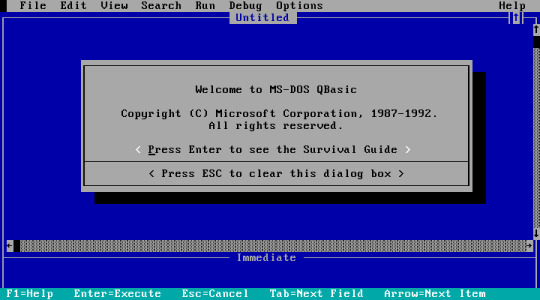
258 notes
·
View notes
Text

@lynxden assuming you meant cpu and not gpu then yes xD
it's basically some of the most memorable and fun moments I've had learning programming has been about doing things the Hard Way™ - doing things manually tends to require you to spend more time thinking about what the computer's actually doing to accomplish the things you ask it to do, which is inevitably a lot more work and often nowhere near as efficient or capable because it's pretty unlikely that you just happen to be smarter than the entire R&D teams they have at Nvidia or Unreal or wherever - but it does force you to learn stuff, at least on a temporary basis.
I mean look, when I first learned how to do proper programming that wasn't just faffing around in Qbasic or whatever, it was on Turbo Pascal in DOS some 25-odd years ago, and I'm kind of forever grateful that when it came to doing graphics, instead of just having us use the built in Borland Graphics API, the teacher taught us how to enter VGA mode 0x13 via direct DOS interrupts, and then how to draw graphics by writing directly to the part of memory that held the screen for that mode.
I still remember the address being 0xA000.
So when I decided I really should take another stab at trying to figure out how the hells matrices work for 2D and 3D transformations a few weeks back, I thought hey why not try doing all of this directly using the Win32 GDI API, BitBlt:ing a framebuffer into the graphics because then I'll also have to re-learn a bunch of stuff that I've more or less forgotten over the years. Plus, there's a part of me that kind of wants to try to take some time to learn at least a little more about software reverse engineering - see if I could ever get to a point where I might be able to look into whether some examples of old games or software that doesn't work so well anymore could be updated to work a bit better.
So, step by step I'm gradually working my way towards a software triangle rasteriser to see about poking around with all of that and I dunno maybe I'll make something small and simple out of it like maybe some vampire survivors-alike or something like the original after burner or maybe even descent or something, who knows.
For now it's mostly a whole lot of googling around, trying to wrap my brain around stuff that feels like I used to find it easier to understand than I do now, and basically just reminding myself why I liked doing some of this stuff, haha.
7 notes
·
View notes
Text
The "QBASIC for Dummies" book I had as a kid had a strange anti-Hippie bent. Which made things odd as fuck when I eventually learned "hippies" was a word that basically meant "my uncles"
6 notes
·
View notes
Text
QBasic Tutorial #55 - Mouse Interface Part 1 - Introduction To Mouse Input Programming ...
youtube
Post #332: YouTube, School Freeware, QBasic Tutorial, #55 Mouse Interface Part 1, Introduction To Mouse Input Programming, 2024.
#retro computing#vintage computing#basic#qbasic#school freeware#progamming#basic programming#basic for ever#basic tutorial
7 notes
·
View notes
Text
Tv in constellation
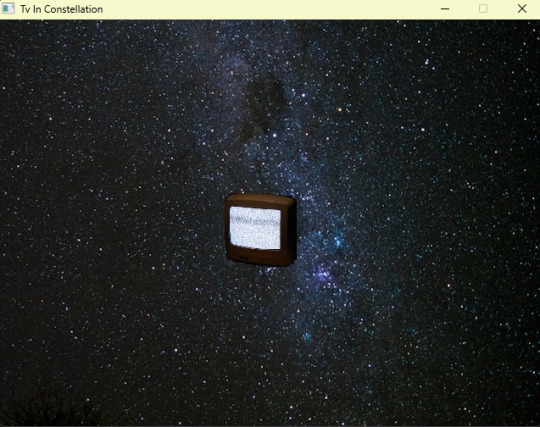
Tele universe - it is true space. Especially, when you moving with using of TV translation with channel or with usage of VHS cassette in a new world. In a far-far galaxy. Or in world of Star Gate. Start Trek. Star Wars. Action movie. Action. All of these - it is so entertaining, and so pulling into. And it drags you in! World of television – universe in a box. High technology.
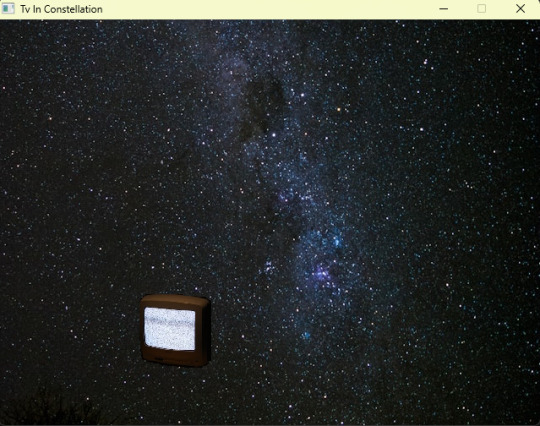
And space. Unlimited space with millions of stars at the sky. Around stars, planets are rotating. And, there are, even, more of them, than stars. More than stars. Nebulas. And galaxies. All of these are unlimited.
Such a feeling of freedom and flight. Television – universe. Magical. Even mystical theme. Modern theme of a modern man. To watch tv. Especially, if it goes there interesting movie or a tv series.

Tv set can be big or not big. Mainly, medium format is rather enough. And, of course, all of these, about a retro theme. TV level of 90s. Or 2000s. Crt tv. Those tv, that you can use to play with cable with three colors in Nes or Sega. And, maybe, even, in first PlayStation.
Whole world – inside television. Mystery. Mystery, which you can look at and, maybe, even, to take a part in format of videogame.
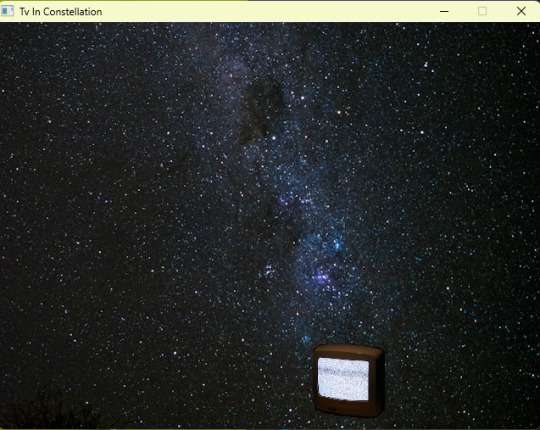
Music theme – it, also, sounds like something mysterious and dragging in. Into the space. Into the tv watching period. Theme is more like stylish and cool 90s or 2000s. When you sit before Tv in the evening. And, try to find something interesting. And, maybe, you can play a console. Music is electronic. Synthesizers. Retrowave. Synthwave.
Retro nostalgia moment. Dedicated to tv. Age of 90s and 2000s. Time, when you spent before tv. While watching some channels and game consoles to play. It is so interesting to turn on television and watch for yourself - does it have for today something interesting! So, this way, one day, I see for the first time Star Gate! They were going by Tv! Or, tv series, or sci fi. Or X-files.
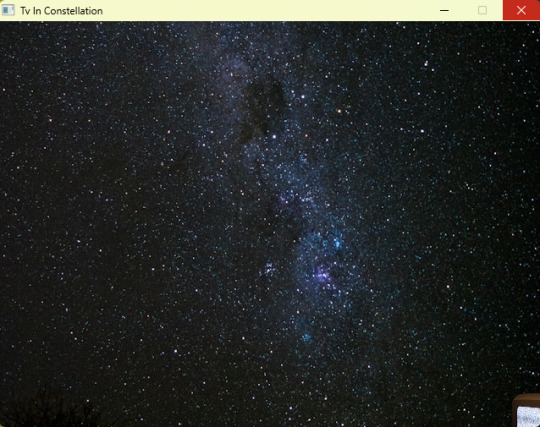
Such an intro. Visual theme. About tv in space. It flies in space. With a random way. And, this is a small program. Program intro. Just, start and watch. At the visual side. With the music. Music is synthesized. Tv is flying in space. Mystery of 20 century. Tv mystery. And space. Tv space. Also, you can see a popular musician by tv. To see cool music clip. Why not – it is a virtual universe. Universe inside universe. Such recursion. As, nesting doll. One inside another one.

Visual fantasy about this theme. A little of mystical. Stars and space. With television, which, simply, is moving there, flying. A little moving, twitching. Stars, stars. To watch a space image – it is, also, standalone thing. And, what is it there amongst the stars? There, it is a tv is flying! So this is a joke answer. It is, simply, intro. It is written with programming language Qb64. In terms of practice and search for a new themes. For point of interest. It is, always, interesting to do something, to try something. Especially, if it goes good. If It turns out. Such idea for simple little programs intros. As intro for some cinema company before movies itself. But, with a form of a small program. With Basic.
It is so nice, in the little evening, to launch little program and to watch, simply, sit and watch! Relax, such modern meditation! Before your eyes – Tv in constellation! In its own constellation. Tele universe. Real one universe. TV moment!

Dima Link is making retro videogames, apps, a little of music, write stories, and some retro more.
WEBSITE: http://www.dimalink.tv-games.ru/home_eng.html ITCHIO: https://dimalink.itch.io/
TUMBLR: https://dimalink.tumblr.com/ BLOGGER: https://dimalinkeng.blogspot.com/ MASTODON: https://mastodon.social/@DimaLink
#retro programming#visual#animation#qbasic#qb64#tv#television#90s aesthetic#constellation#space#application#program#mystery#sci fi#surreal#tv series#crt tv#digital art#future#nostalgia#time for a tv#white noise#intro#strange#tv in space
12 notes
·
View notes
Text
Qub – a framework for building websites with QBasic
https://github.com/jamonholmgren/qub
2 notes
·
View notes
Video
youtube
MixMystery - Cooey's Call - Feral (Piano Version)
2 notes
·
View notes
Text
Czarina-VM, study of Microsoft tech stack history. Preview 1

Write down study notes about the evolution of MS-DOS, QuickBASIC (from IBM Cassette BASIC to the last officially Microsoft QBasic or some early Visual Basic), "Batch" Command-Prompt, PowerShell, Windows editions pathing from "2.11 for 386" to Windows "ME" (upgraded from a "98 SE" build though) with Windows "3.11 for Workgroups" and the other 9X ones in-between, Xenix, Microsoft Bob with Great Greetings expansion, a personalized mockup Win8 TUI animated flex box panel board and other historical (or relatively historical, with a few ground-realism & critical takes along the way) Microsoft matters here and a couple development demos + big tech opinions about Microsoft too along that studious pathway.
( Also, don't forget to link down the interactive-use sessions with 86box, DOSbox X & VirtualBox/VMware as video when it is indeed ready )
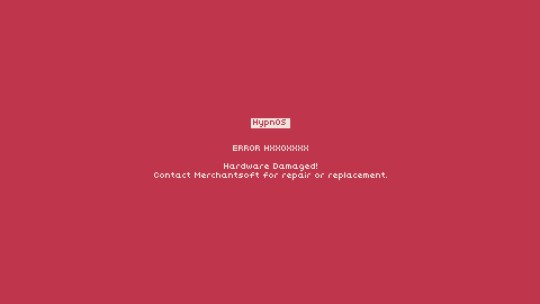
Yay for the four large tags below, and farewell.
#youtube#technology#retro computing#maskutchew#microsoft#big tech#providing constructive criticisms of both old and new Microsoft products and offering decent ethical developer consumer solutions#MVP deliveries spyware data privacy unethical policies and bad management really strikes the whole market down from all potential LTS gains#chatGPT buyout with Bing CoPilot integrations + Windows 8 Metro dashboard crashes being more examples of corporate failings#16-bit WineVDM & 32-bit Win32s community efforts showing the working class developers do better quality maintenance than current MS does
5 notes
·
View notes
